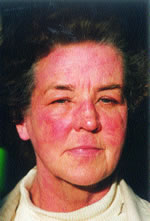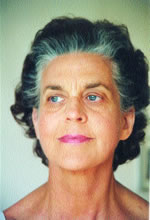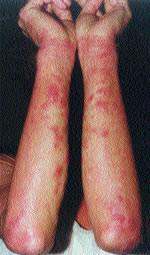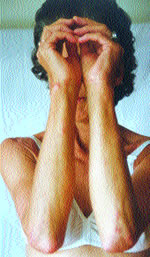Positive Health Online
Your Country

Eczema and Food Allergy
listed in allergies, originally published in issue 81 - October 2002
My Story
The Symptoms
Asthma has always been part of my life, but never eczema. I was 57 when it started. I thought nothing of it – just two little, itchy patches on my legs – nothing that could have told me of the horror to come.
Within about six months these two little patches had spread to cover my entire body from my forehead to my feet. Hard lumps, about the size, shape and colour of red kidney beans, developed under the skin all up my arms and legs. Water poured out of my body and my skin was sloughing off all over, while my legs were swollen up to look like elephant's legs. With my hair and eyebrows coming out and my face bright red and all puffed up, my appearance changed beyond recognition. And the itching...!
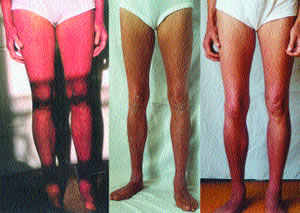
Nothing in the worst nightmares of horror stories can describe the itching, which seemed to lie deep beneath the surface of the skin. One goes frantic trying to dig it out. I remember writhing around on the floor, trying to scratch my back on the kitchen tiles while I scratched my legs at the same time. I recall lying awake, or prowling around the house all night, many nights, scratching and crying. I recollect thrusting my arms and shoulders into the freezer. I remember, not just once, but many times, plunging into a bath full of cold water in the middle of the night in mid-winter. I recall standing naked outside the back door in the wind and the rain, trying to ease my frantic body. My mind went to pieces. I could neither read nor write nor play the piano nor listen to music. Sometimes I could barely conduct a rational conversation. I have suffered terrible pain in my life, but perpetual itching is far worse and can best be described as millions of insects crawling around under the skin, scratching and biting and nibbling incessantly.
|
|
|
|
|
Identifying the Causes of Eczema
Doctors maintained that the cause of eczema was unknown, and that it was incurable. I had all the usual treatments – steroids, emollients, antihistamines, ultraviolet rays and antibiotics. But nothing touched the eczema. I spent a small fortune on alternative therapies – acupuncture, homeopathy, Chinese medicines, herbalism, hypnotherapy – you name it, I tried it. But nothing helped.
Only those with severe eczema can know the depths of suffering and despair involved. Eczema doesn't kill you – it's not so merciful. It just drives you stark, raving mad. It breaks my heart to think of people suffering in the way I used to, and know that they can find no relief.
One day I had a Chinese meal, and was very sick afterwards. I could not eat for four or five days. During that time, the eczema virtually cleared up. When I started eating again, the eczema came back. I now had the clue to the cause: food allergy. In delight, I told my doctor and the consultant dermatologist and dietitian at the hospital. They all smiled kindly and said that it was a coincidence – that there was no connection between food and eczema. I didn't believe them.
On my own I tried cutting out foods but with no success and increasing despair. (I know now that this is a dangerous practice and should not have been attempted. But when you are desperate you will try anything.) Many months passed in this way, and I drew very close to suicide, but in God's mercy, quite by chance, I met a retired doctor with a special interest in allergies. He was 84 years old but he took pity on me and guided me through an elimination diet. With the right diet the eczema cleared completely in about three weeks.
My Elimination Diet
First I was told to eat only organic foods, to drink no tap water, and to exclude chemicals from my diet. I eliminated from my diet the most common allergenic foods – dairy produce, wheat, sugar, yeast, nuts, alcohol – but it made no difference. Then Dr A (who wishes to remain anonymous) took all fruits from my diet, explaining that fruit contributes to eczema quite significantly. All my life I have been a vegetarian, and it was a terrible wrench to remove my favourite food – fruit – but I was desperate and did so. It made no difference. The eczema raged as before. Dr A told me that I must start to eat meat, because meat is the least allergenic of foods, while fruit and vegetables are the most likely to cause an allergic reaction. For several weeks I resisted, finding the idea of meat-eating nauseating, and existed on a monotonous diet of vegetables only, with no grains, no dairy produce, no sugar and no fruit. It was awful, but the worst of it was that there was no remission of the eczema. I was in despair. Dr A got very firm, even cross. He told me that I was a fool, and that I must eat meat and cut out the plant foods altogether. I capitulated and did so. Within 24 hours my skin had stopped itching, within a week it was significantly better, and after three weeks the eczema had gone completely.
Eczema is an allergic disease, caused by many things – dust, animals, grasses, pollens, moulds and chemicals. However, I am convinced that what we eat and drink contributes more to eczema than doctors or dietitians will usually accept. It amazes me that the medical profession still rejects out of hand the possibilities of diet, and continues to prescribe steroids, antibiotics, immunosuppressors such as Cyclosporin and other powerful and harmful drugs that temporarily suppress symptoms but do not address the cause. For this reason I have written a book Eczema and Food Allergy.[1] As far as I know it is the only book available that deals with the connection between food and eczema.
Tips for Other Eczema Sufferers
People with eczema will want to know how I did it. Let me first say, it is not easy. There is no quick fix. Secondly, do not attempt an elimination diet alone–- you will not be successful. I advise finding an experienced and properly trained nutritionist[2] (check the training and credentials) or a dietitian specializing in allergies[3] (dietitians are not all trained in allergies) or a doctor who specializes in allergies.[4] Above all, do not try an elimination diet on a child without expert advice.
A few general points might be helpful. Eliminate all chemicals from the food or drink you take into your body. This is very hard, because almost everything on the shelves of supermarkets is loaded with chemical additives, and so is tap water. This can be time consuming and expensive, but it must be done, especially for a child. Personally, I think that chemicals in our diet and environment are the root cause of the rise in allergic diseases. Our bodies are so overloaded with chemicals that breakdown point is reached.
But organic foods alone will not be the answer. For some reason that no one can explain, it seems to be the foods themselves that are causing the trouble. Dairy produce – milk, cheese, butter, eggs - are the most troublesome. This must include any foods with a trace of dairy products in them, so this will mean virtually all packaged or processed foods. Wheat and gluten cause a lot of allergic diseases and, as wheat is a primary food, used throughout the food industry, you will need expert advice to provide substitutes. Fish, especially shellfish and crustaceans, can be very harmful. Usually meat is safe to eat. Sugar and yeast have a bad record, and this is because they are a growth factor for Candida albicans. Most people, including children, with an allergic disease have a fungal imbalance of the gut flora of which they are unaware, and which gives rise to a leaky gut. Expert treatment is required for this condition, which can be incredibly hard to rectify. Fruit, especially citrus and all the berry fruits, seems to provoke a lot of eczema. Perhaps that is because they are eaten raw, and if they are cooked they are less troublesome. In fact, overall, cooked things seem to be more acceptable than raw foods. Another rule of thumb is that favourite foods are always the culprits.
All food allergy or intolerance is different in each person, and there is no prescriptive remedy, which is why I cannot say in a short article, "Do this or do that and your eczema will be cured". If it were as easy as that, everyone would be doing it, wouldn't they?
Testing for food allergy and intolerance is unreliable. The best is the RAST blood test, which can only be ordered by a doctor, but even that is not 100% accurate. Testing for food allergies is the latest gimmick, and some of them are downright fraudulent. The York Nutritional Laboratories are helpful, but no tests are as reliable as an elimination diet properly controlled and conducted by an expert.
This can only be a very brief introduction to the complex and bewildering subject of food allergy and intolerance. I always advise people to learn as much as possible about allergies, and a list of societies to join and books to read can be found at the end of this article.
The Next Step – Immunotherapy
But my story is not finished. I had cured the eczema, but was left with virtually nothing to eat. Any attempt to reintroduce foods resulted in a return of the eczema. Something had to be done. My doctor referred me to Professor Jonathan Brostoff at the Middlesex Hospital (he has since retired) who advised a course of Enzyme Potentiated Desensitization (EPD). I started it about four to five years ago, and the success has been total. I can now eat anything and everything with no return of the dreaded eczema.
Many people have asked what EPD is. How does it work? Where can it be obtained? I will try to give a brief summary.
There are two forms of immunotherapy available:
1. Enzyme Potentiated Desensitization (EPD);
2. Neutralization Technique.
Both methods are equally effective in the treatment of allergic diseases. Allergic people have a dysfunction of the immune system, and a low tolerance level to allergens. Avoiding all the allergens encountered in modern life is impossible, so the only way forward is to immunize the body against them. The concept of immunotherapy has a long history. In 1906 a method was developed called Incremental Immunotherapy (IIT). The method consisted of injecting small doses of allergens – dust, grass, pollens, etc. – into a patient and, over a period of months, increasing the dose with each injection. In the 1980s IIT was withdrawn from use in the UK.
In the 1960s two new forms of immunotherapy were developed quite independently of each other – EPD and Neutralization. Both methods are effective in immunizing the body against the harmful effects of nearly all allergens, such as dust, moulds, foods, grasses, fur, feathers and many chemicals, and both methods are now used worldwide.
EPD and Neutralization are not accepted by the established medical profession, and many doctors have never even heard of them. Some doctors will confuse them with the old IIT method and will say that immunotherapy has been withdrawn from use. This is correct only for IIT. The two methods that I am talking about – EPD and Neutralization – have not been withdrawn.
Enzyme Potentiated Desensitization (EPD)
This was developed in the 1960s in England by Dr L M McEwen and is now used worldwide. It is effective for the treatment of all allergic diseases, and the safety record is impressively high. A natural bodily enzyme – beta-glucuronidase – is mixed with minute amounts of allergenic substances and injected into the body at intervals of three months. The immune system gradually becomes stabilized, and the sensitivity to allergens is reduced, or even eliminated, over a period of years. A brief article is not the place in which to give a lot of detail, but in my book1 I devote two chapters to EPD.
Neutralization Technique
This was developed in the 1960s in America by Dr J B Miller and is now used worldwide for the treatment of all allergic diseases. Diagnostic testing consists of a serial dilution (rather like a homeopathic dilution) of known or suspected allergens being injected intradermally into the patient's arm from stronger to weaker dilutions. The dilution that produces no reaction is the neutralizing point.
This dilution is the treatment dose, which is then prepared and given to the patient for self-administration. Neutralization Therapy can be taken in two ways: intradermal injection or drops under the tongue. (Neutralization is sometimes called 'the drops method'.)
Improvement can be immediate, but this will quickly wear off, and treatment must be continued for two to three years for long-term benefit. Neutralization is effective, and has a good safety record when administered by an experienced doctor.
Where Can I get Immunotherapy Treatment?
EPD and Neutralization are individualized forms of immunotherapy in the way they are prescribed and administered. Nothing can be standardized. For this reason neither can be given a 'Full Product' licence by the Medical Control Agency, but they have a 'Special Licence'. The vaccine is only available to a registered doctor who specializes in allergies and has, additionally, been trained in its use. Therefore do not go to anyone who is not a doctor for either EPD or Neutralization. I have heard of people with no medical training whatever who claim to practice immunotherapy. This is fraudulent, and can be highly dangerous.
Treatment is almost entirely in the private sector of medicine, and the secretary of the British Society for Allergy, Environmental and Nutritional Medicine,4 will supply a list of practitioners on request. In addition, the Royal London Homeopathic Hospital,[5] has an allergy clinic with a team of five doctors who offer EPD on the NHS via a medical referral. The Centre for the Study of Complementary Medicine in Southampton practise both EPD and Neutralization.[6]
Personal Postscript
Life is a mystery that none can fathom. I believe now that severe eczema was sent to me for a purpose. People who have lived through a near-death experience always say that every day is precious and filled with a radiant light. That is how I feel every minute of every day. Joy and gratitude that the eczema has gone overwhelm me sometimes, and I want to sing and dance for joy. I take nothing for granted, and thank God all the time for His mercy and love. It breaks my heart that thousands of people suffer eczema, some of them as severely as I did, and that they can find no relief. It was for this reason that I wrote my book Eczema and Food Allergy1 - I felt compelled to do it, as though a guiding hand was directing my pen. I know from the letters I receive that it has helped a great many people.
Notes and References
1. Worth Jennifer. Eczema and Food Allergy. Merton Books. 1997.
2. Institute of Optimum Nutrition, Blades Court, Deodar Road, Putney; Tel: 020 8877 9993.
3. British Dietetics Association, Charles House, Great Charles Street, Queensway, Birmingham; Tel: 0121 200 8080.
4. British Society for Allergy, Environmental and Nutritional Medicine, PO Box 7, Knighton LD7 1WF; Tel: 01547 550380.
5. Royal London Homeopathic Hospital, Great Ormond Street, London WC1N 3HR; Tel: 020 7837 8833.
6. The Centre for the Study of Complementary Medicine, 51 Bedford Place, Southampton SO15 2DT; Tel: 023 8033 4752.
Further Reading
Brostoff Jonathan and Gamlin Linda. The Complete Guide to Food Allergy and Intolerance. Bloomsbury. 1998.
Further Information
For information about allergic diseases contact:
Action Against Allergy, PO Box 279, Twickenham, TW1 4QQ; Tel: 0208 892 4949; or
National Society for Research into Allergy, PO Box 45, Hinkley, Leicestershire LE10 1JY; Tel: 01455 250715.
Comments:
-
No Article Comments available
